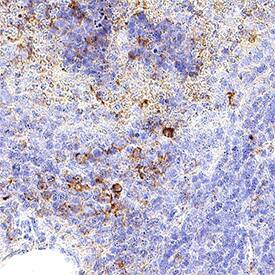Mouse CD14 Antibody
R&D Systems, part of Bio-Techne | Catalog # MAB982

Key Product Details
Species Reactivity
Validated:
Mouse
Cited:
Mouse
Applications
Validated:
Immunohistochemistry, Western Blot
Cited:
Binding Assay, Immunocytochemistry, Immunohistochemistry-Paraffin, In vivo assay, Neutralization
Label
Unconjugated
Antibody Source
Monoclonal Rat IgG2A Clone # 159010
Product Specifications
Immunogen
Mouse myeloma cell line NS0-derived recombinant mouse CD14
Ala18-Pro345 (predicted)
Accession # P10810
Ala18-Pro345 (predicted)
Accession # P10810
Specificity
Detects mouse CD14 in direct ELISAs and Western blots. In direct ELISAs and Western blots, approximately 10% cross-reactivity with recombinant human CD14 is observed.
Clonality
Monoclonal
Host
Rat
Isotype
IgG2A
Scientific Data Images for Mouse CD14 Antibody
Detection of Mouse CD14 by Western Blot.
Western blot shows lysate of J774A.1 mouse reticulum cell sarcoma macrophage cell line. PVDF membrane was probed with 1 µg/mL of Rat Anti-Mouse CD14 Monoclonal Antibody (Catalog # MAB982) followed by HRP-conjugated Anti-Rat IgG Secondary Antibody (Catalog # HAF005). A specific band was detected for CD14 at approximately 50-55 kDa (as indicated). This experiment was conducted under reducing conditions and using Immunoblot Buffer Group 1.Detection of CD14 in Mouse Spleen.
CD14 was detected in immersion fixed paraffin-embedded sections of mouse spleen using Rat Anti-Mouse CD14 Monoclonal Antibody (Catalog # MAB982) at 5 µg/ml for 1 hour at room temperature followed by incubation with the Anti-Rat IgG VisUCyte™ HRP Polymer Antibody (Catalog # VC005). Before incubation with the primary antibody, tissue was subjected to heat-induced epitope retrieval using VisUCyte Antigen Retrieval Reagent-Basic (Catalog # VCTS021). Tissue was stained using DAB (brown) and counterstained with hematoxylin (blue). Specific staining was localized to the cytoplasm and membrane. View our protocol for Chromogenic IHC Staining of Paraffin-embedded Tissue Sections.Applications for Mouse CD14 Antibody
Application
Recommended Usage
Immunohistochemistry
3-25 µg/mL
Sample: Immersion fixed paraffin-embedded sections of mouse spleen
Sample: Immersion fixed paraffin-embedded sections of mouse spleen
Western Blot
1 µg/mL
Sample: J774A.1 mouse reticulum cell sarcoma macrophage cell line
Sample: J774A.1 mouse reticulum cell sarcoma macrophage cell line
Reviewed Applications
Read 1 review rated 5 using MAB982 in the following applications:
Formulation, Preparation, and Storage
Purification
Protein A or G purified from hybridoma culture supernatant
Reconstitution
Reconstitute at 0.5 mg/mL in sterile PBS. For liquid material, refer to CoA for concentration.
Formulation
Lyophilized from a 0.2 μm filtered solution in PBS with Trehalose. See Certificate of Analysis for details.
*Small pack size (-SP) is supplied either lyophilized or as a 0.2 µm filtered solution in PBS.
*Small pack size (-SP) is supplied either lyophilized or as a 0.2 µm filtered solution in PBS.
Shipping
Lyophilized product is shipped at ambient temperature. Liquid small pack size (-SP) is shipped with polar packs. Upon receipt, store immediately at the temperature recommended below.
Stability & Storage
Use a manual defrost freezer and avoid repeated freeze-thaw cycles.
- 12 months from date of receipt, -20 to -70 °C as supplied.
- 1 month, 2 to 8 °C under sterile conditions after reconstitution.
- 6 months, -20 to -70 °C under sterile conditions after reconstitution.
Background: CD14
References
- Wright, S.D. et al. (1990) Science 249:1431.
- Pugin, J. et al. (1993) Proc. Natl. Acad. Sci. USA 90:2744.
- Beutler, B. (2000) Current Opinion in Immunology 12:20.
- Stelter, F. (2000) Chem. Immunol. 74:25.
Alternate Names
CD14
Gene Symbol
CD14
UniProt
Additional CD14 Products
Product Documents for Mouse CD14 Antibody
Product Specific Notices for Mouse CD14 Antibody
For research use only
